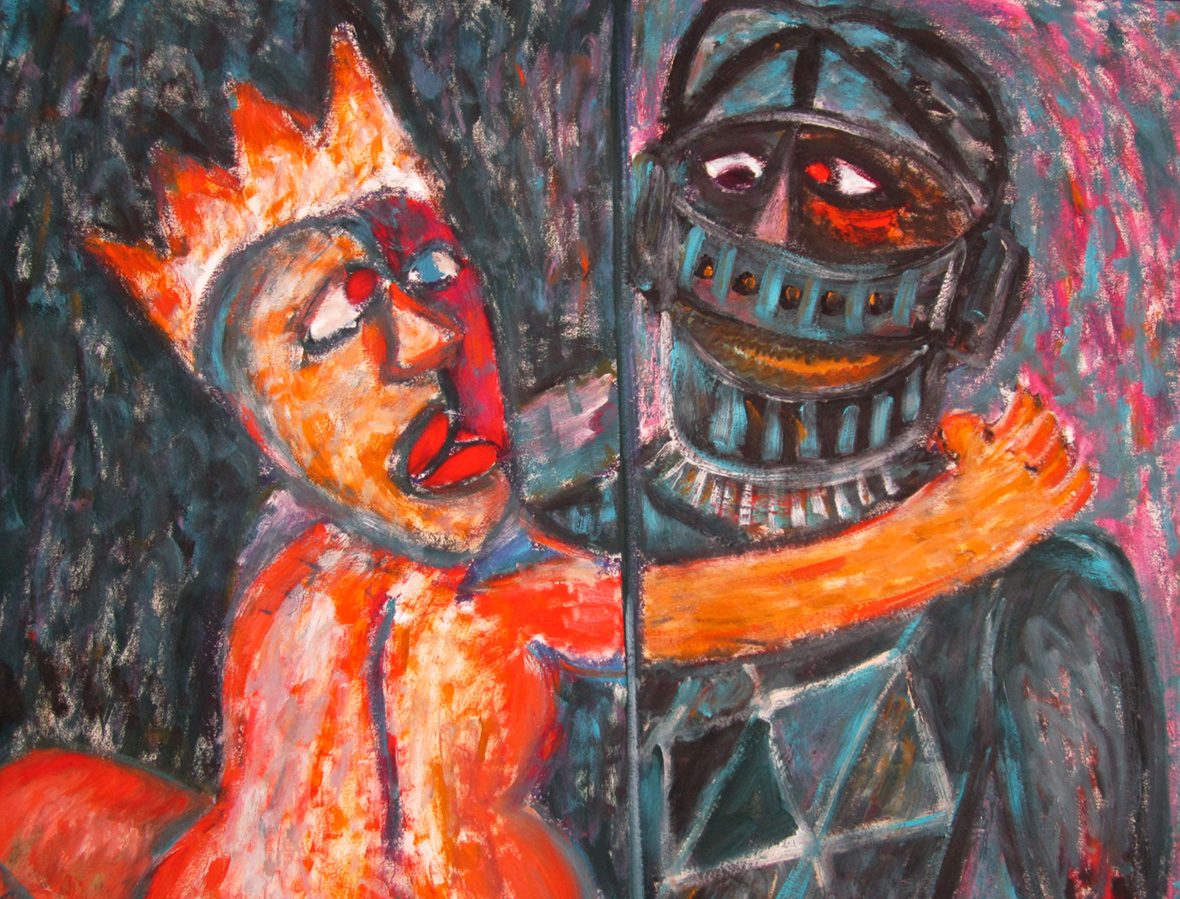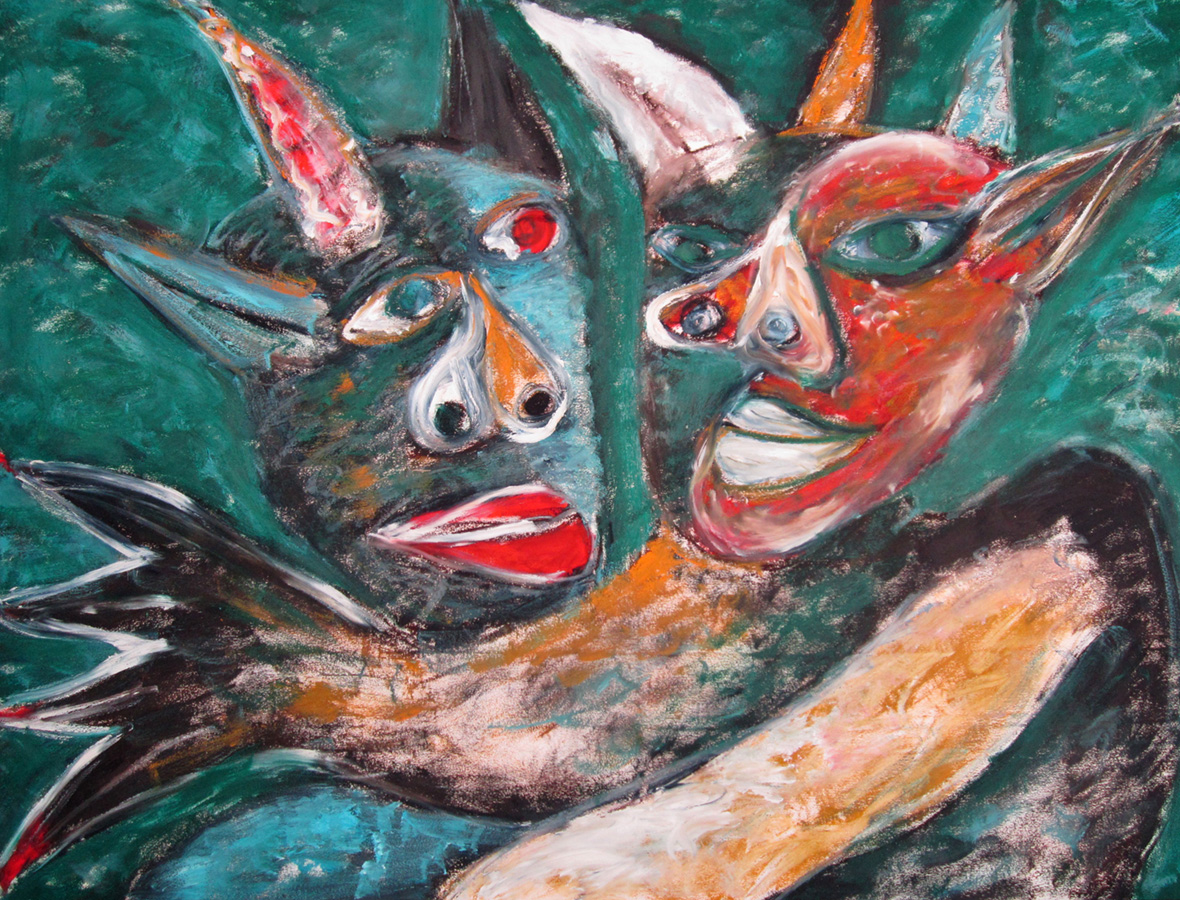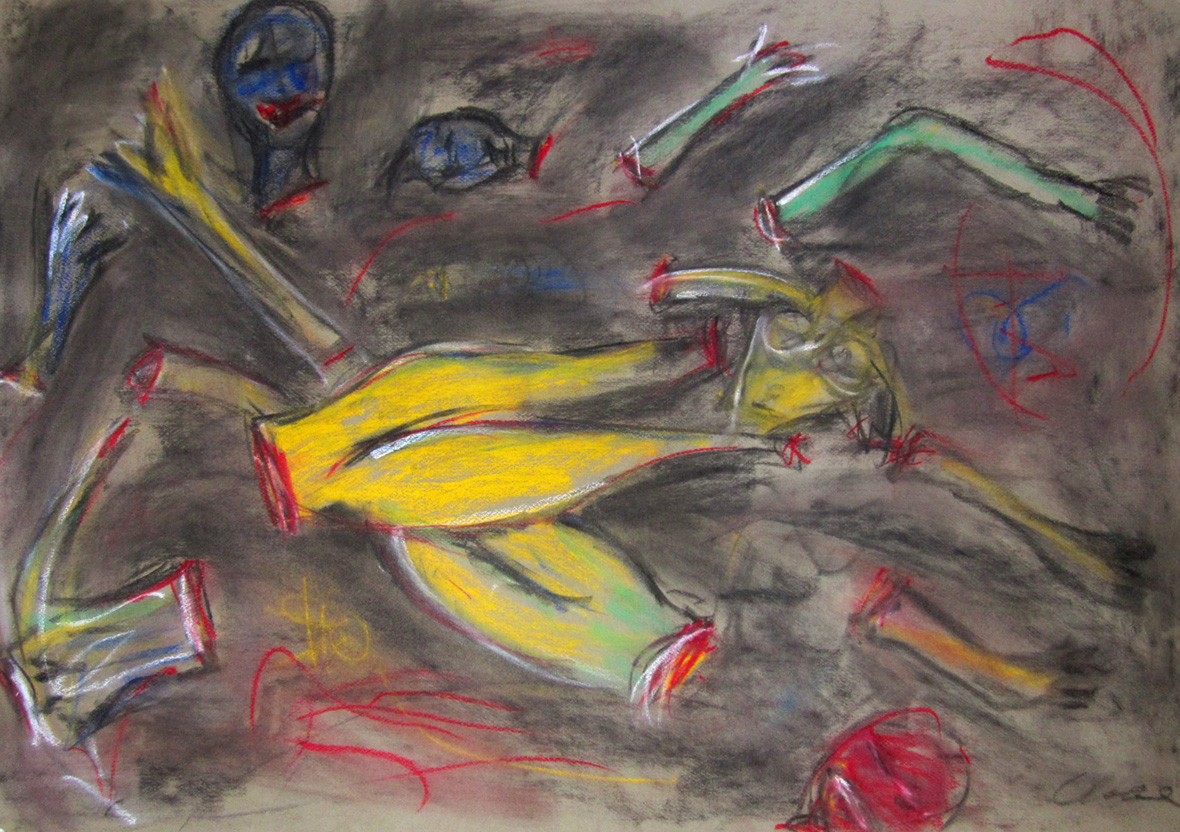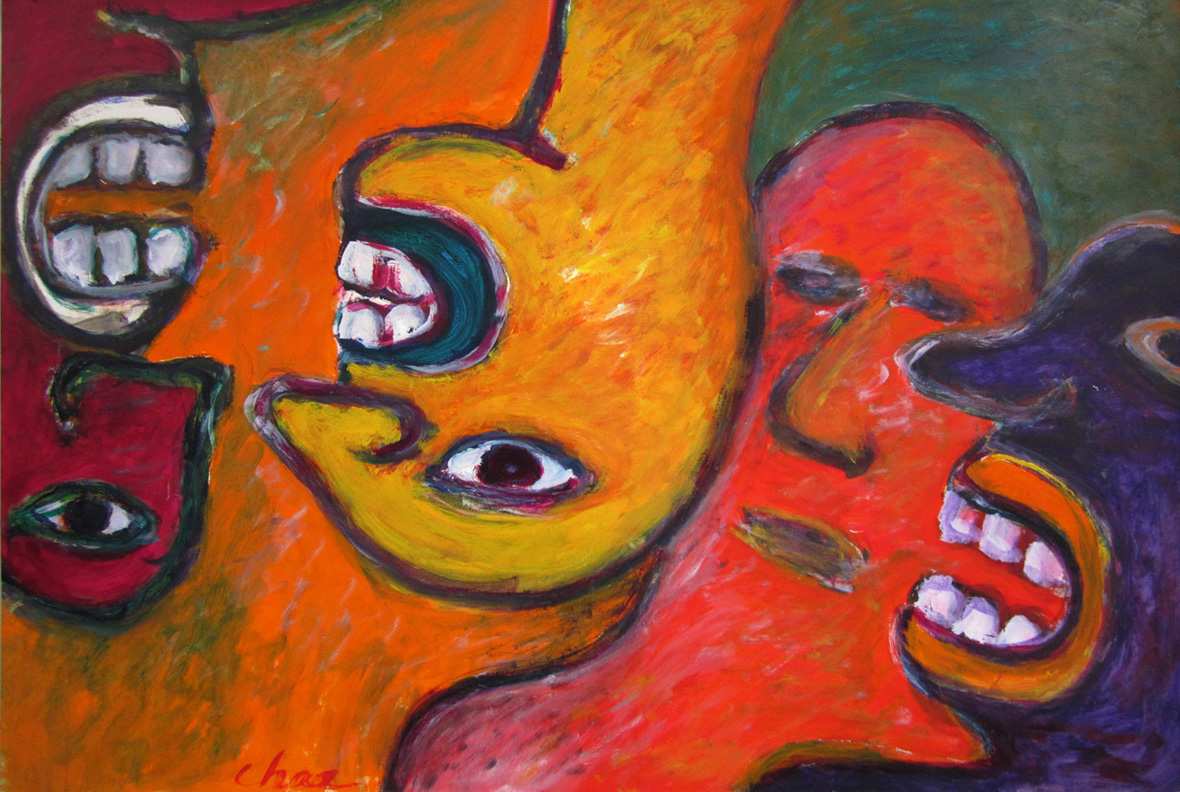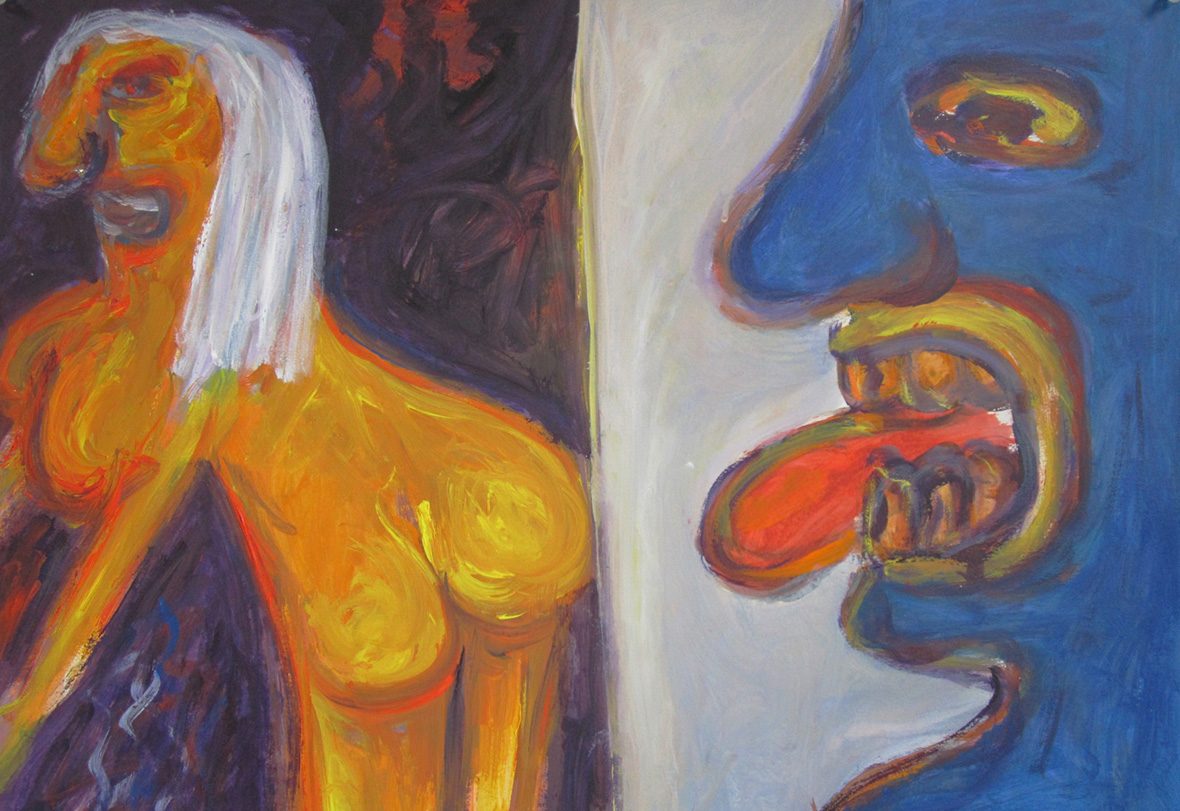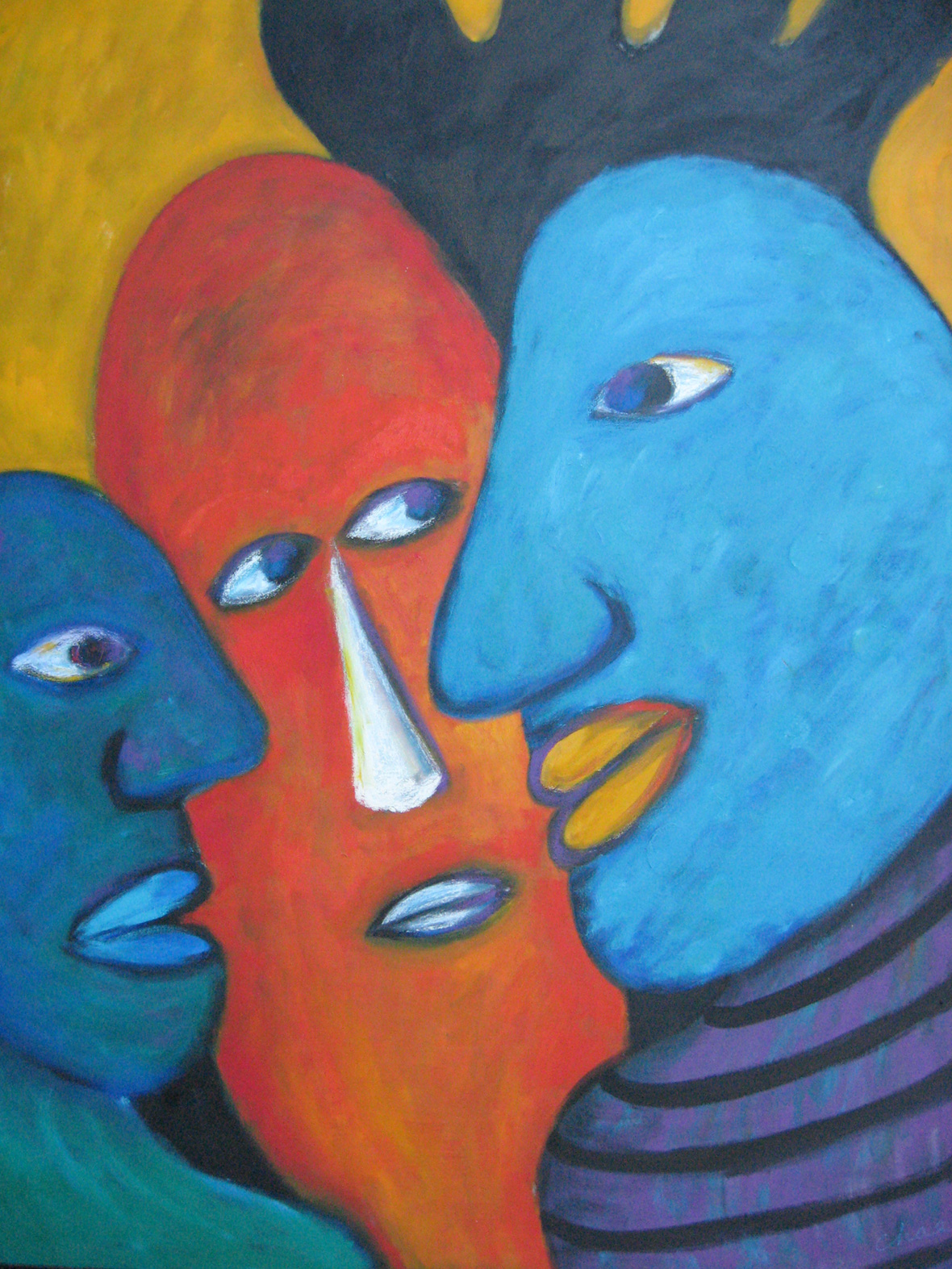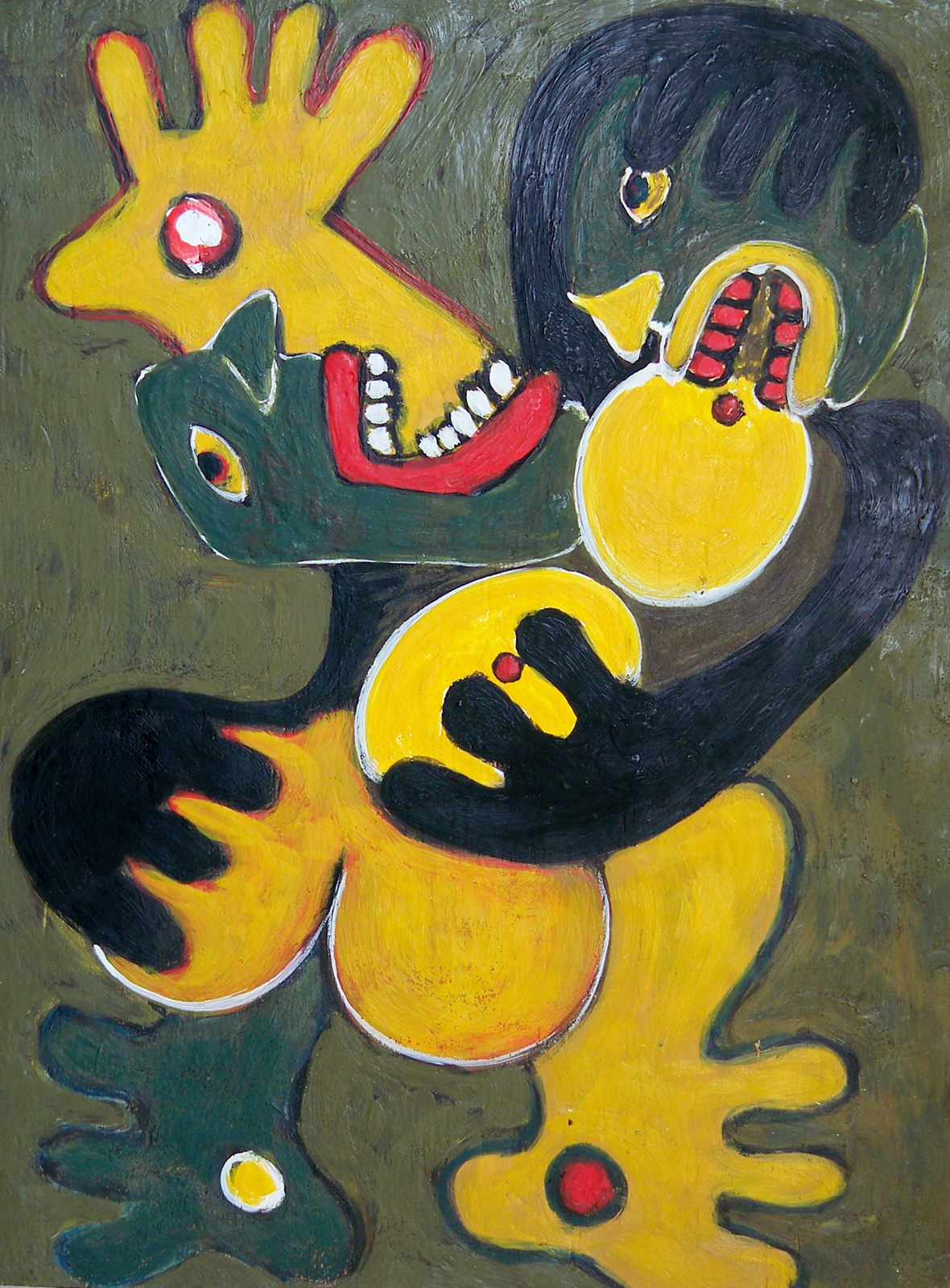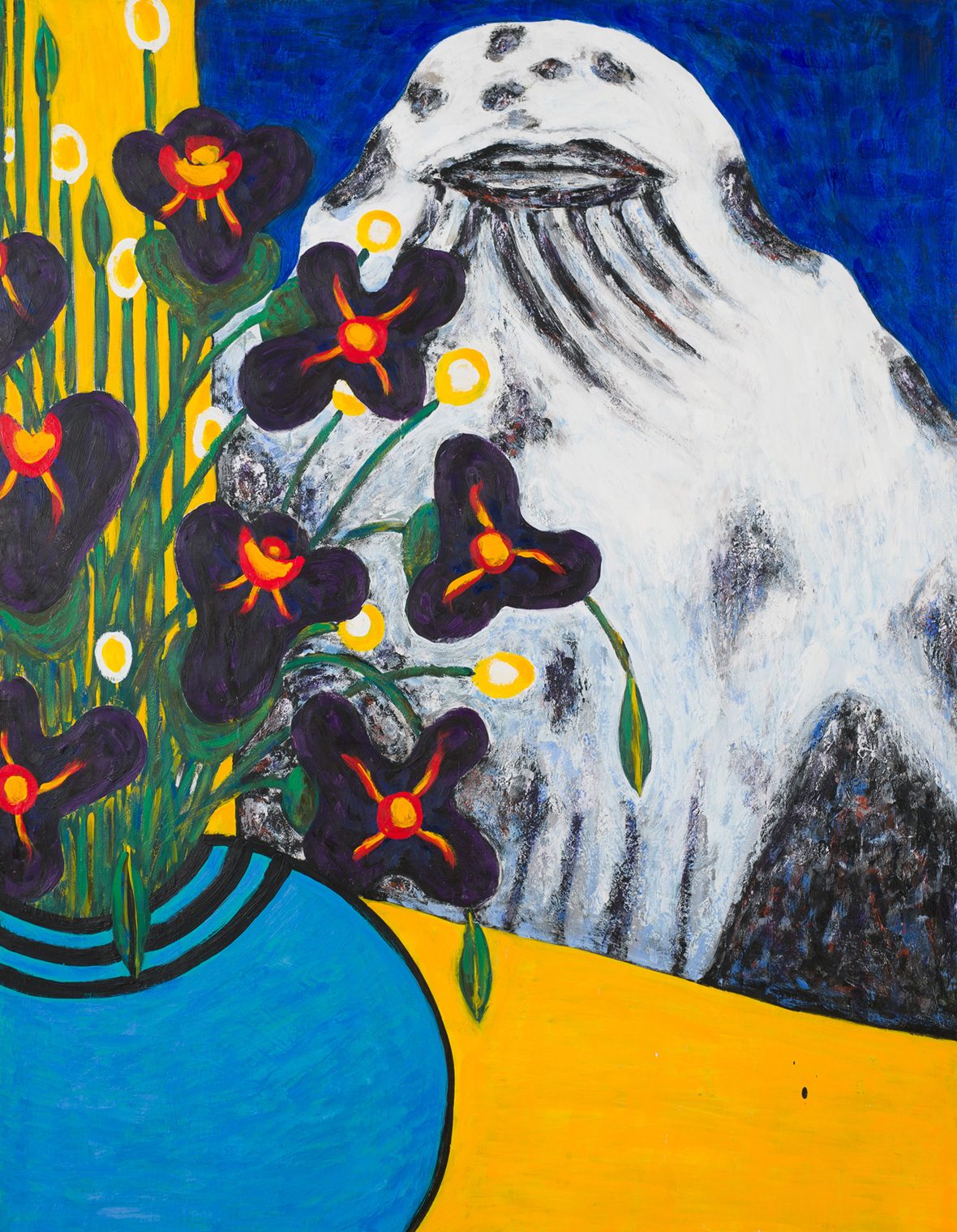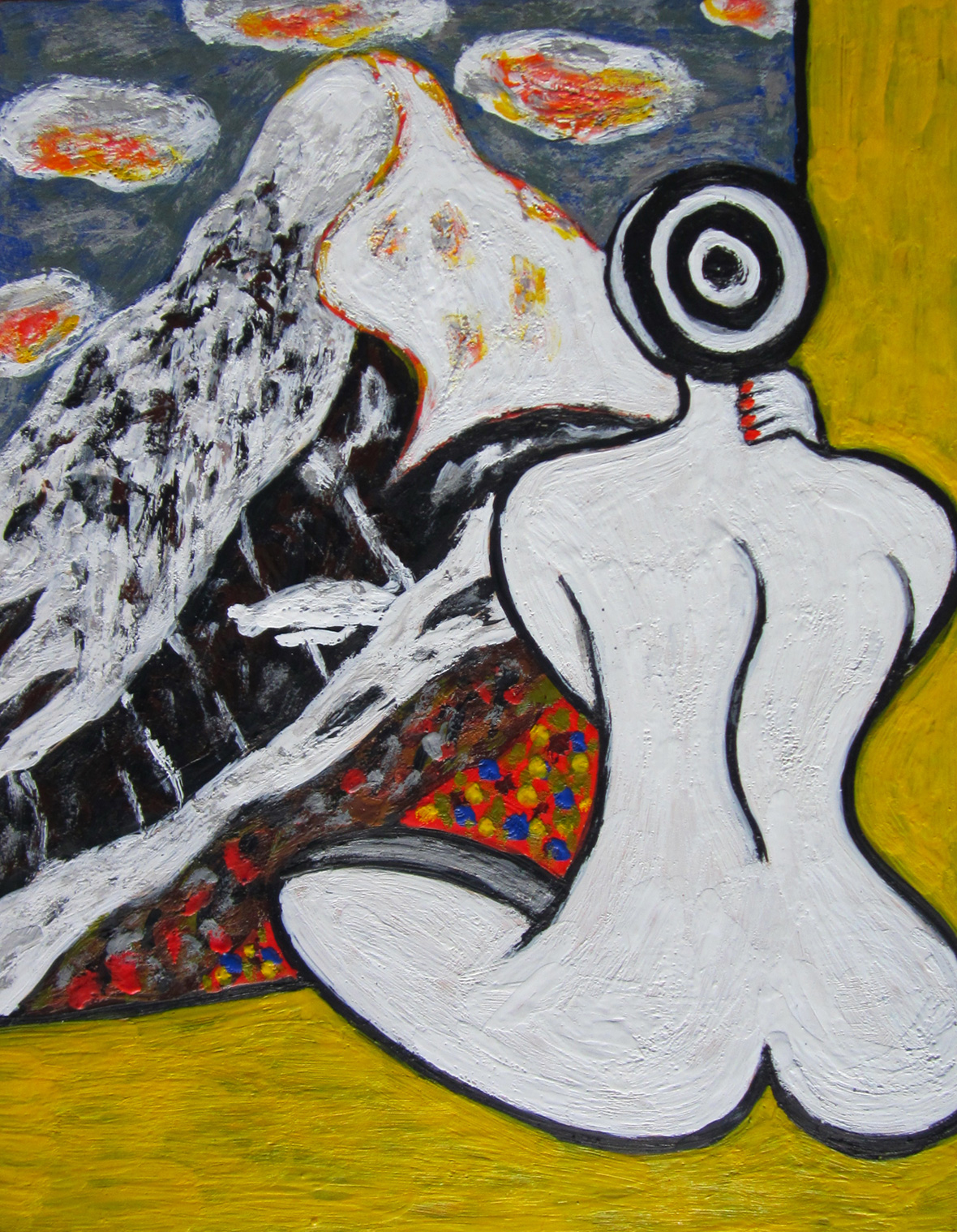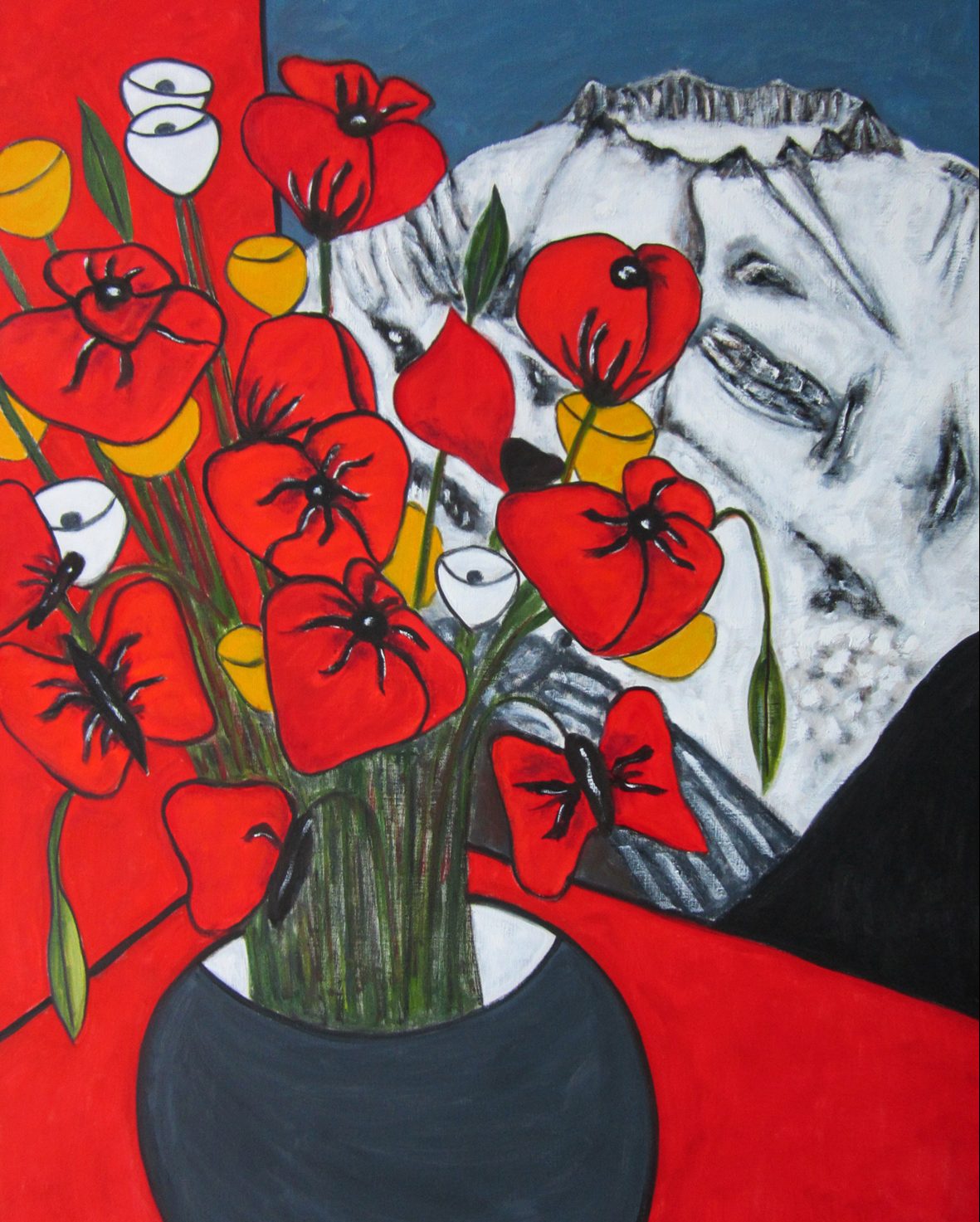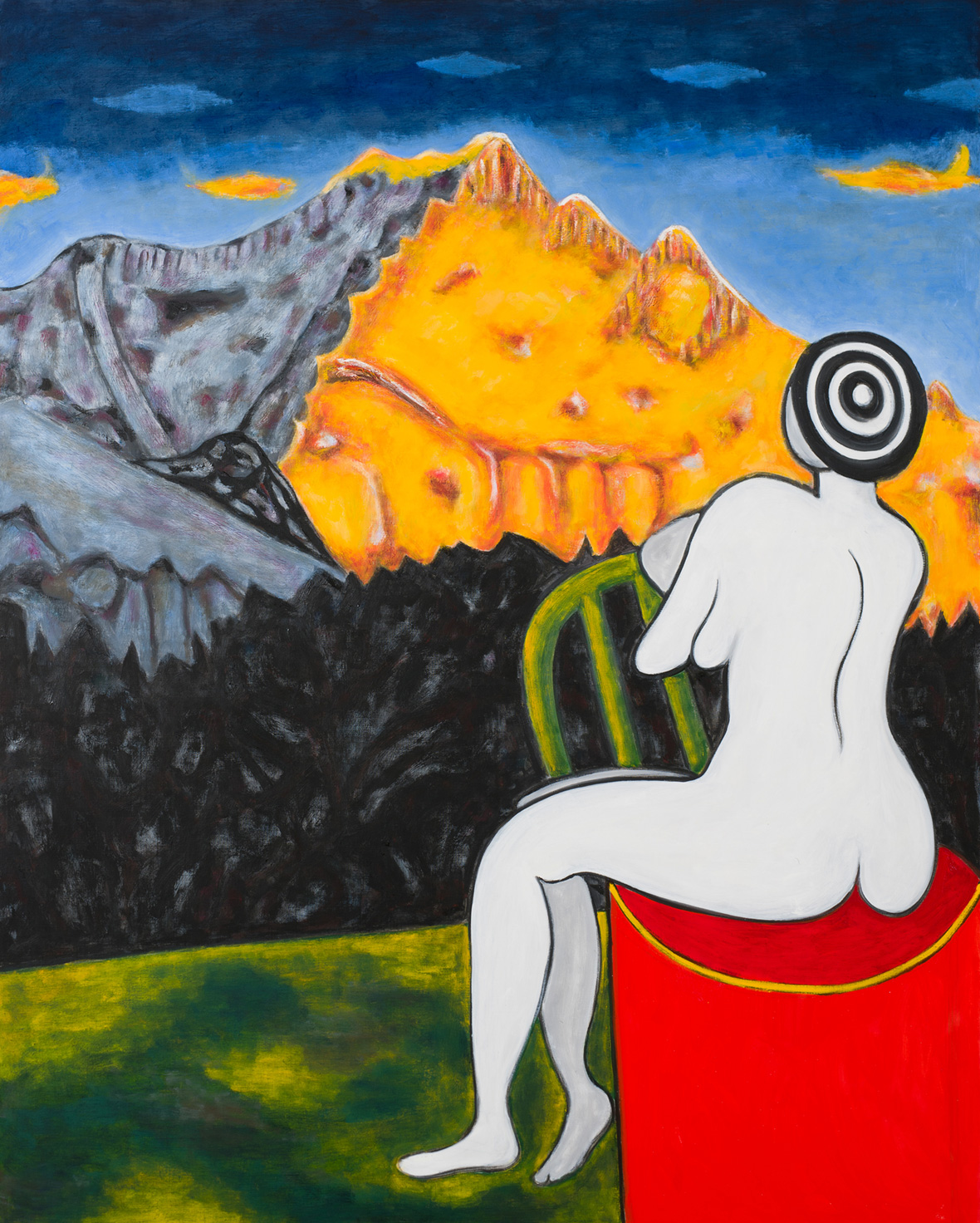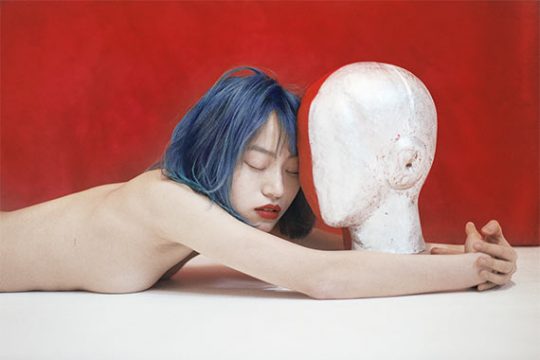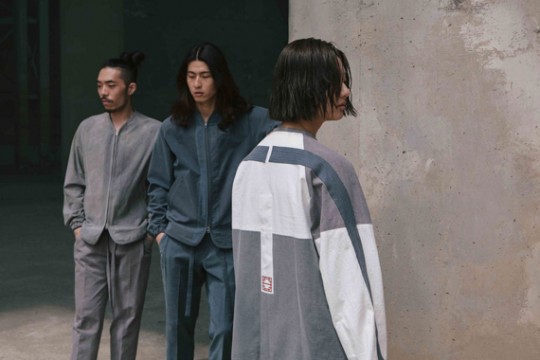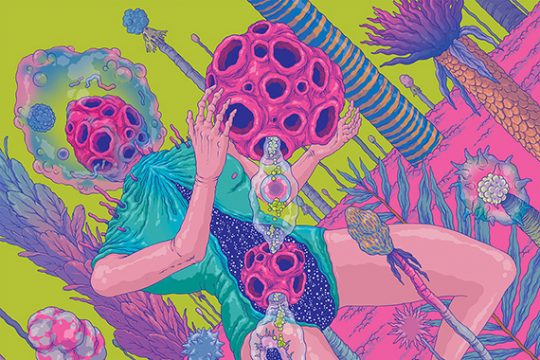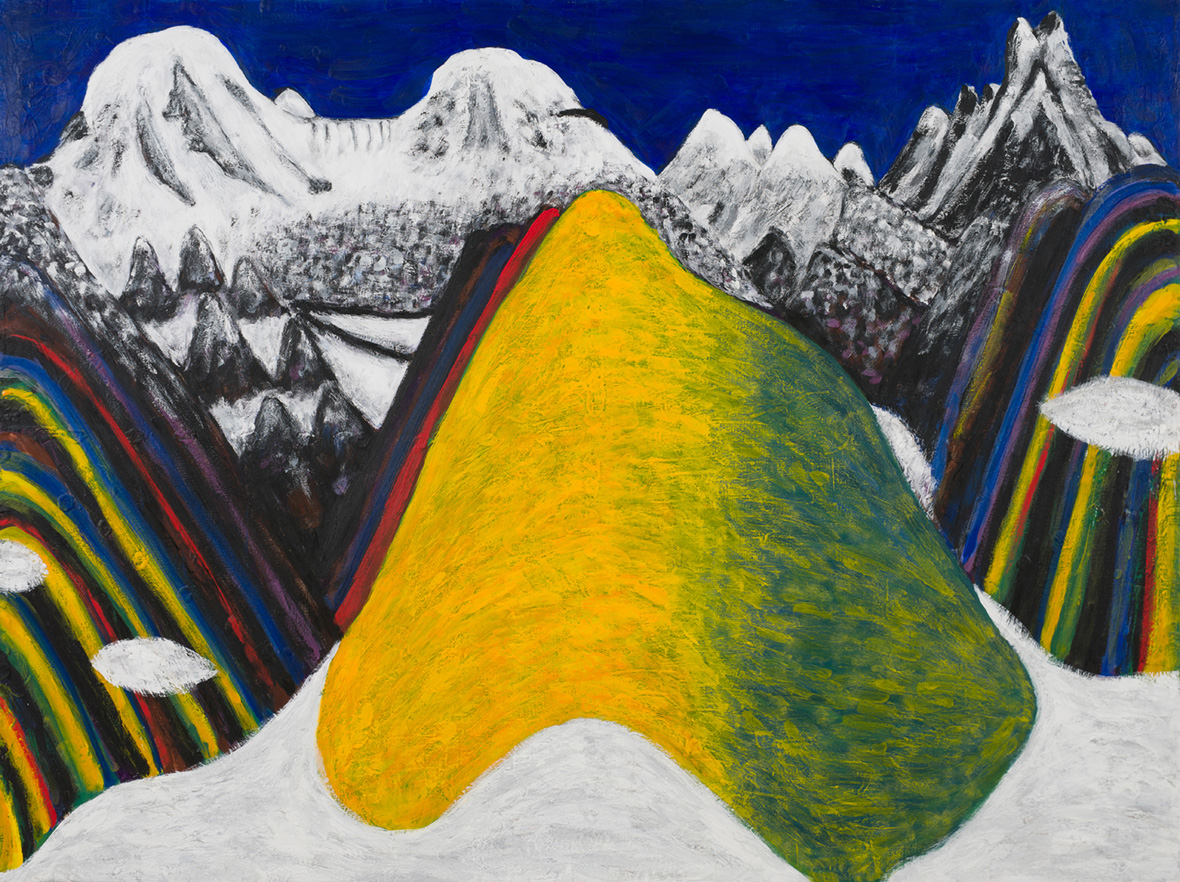
The trade routes that linked distant civilizations along the silk road were paved in peril. Only caravans of enterprising merchants, soldiers, and bandits were brave enough to travel the sprawling deserts and grasslands between Europe and Asia, discovering cities such as Samarkand, Xi’an, and Kashgar, whose vowel-rich titles rise and fall in sharp syllables like the spires of their towers. Yet, it wasn’t only merchants and conquering armies who found providence within the walls of these fortified cities—but also ideas, philosophies, and art.
Korean-born painter Chae Tongyull understands this history well. He has spent his whole adult life tracing the footsteps of nomadic people throughout Asia, Europe, and the Middle East, carving out trails in some of the most remote and dangerous areas of the world. Yet, unlike the ancient marauders and merchants of old, Chae’s pursuit is not for fortune or gold, it’s for artistic inspiration. At each new juncture on his voyage—a thatched hut deep in the Yucatan jungle, a cheap church-loft in the most dangerous neighborhood of 1980s New York, a makeshift shelter at the highest peaks of the windy Himalayas—he maintains an eye not for detail, but for humanity, attempting not just to observe, but to embed himself in the local community. However, if one wishes to fully scale the breadth of humanity’s most beautiful peaks, one is also duty-bound to descend into the shadows of her deepest and darkest valleys.
丝绸之路起源于公元前二百年的西汉,当时汉武帝派遣张骞出使西塞传播丝绸,他一路从中国中代都城长安,穿越中亚国家、阿富汗、伊朗、伊拉克、叙利亚等地而达地中海,最终落脚于罗马,开辟了这条贯穿千年的道路,连接起数个遥远的文明。西安、撒马尔罕、和喀什……这些城市的名字在短促的音节中起起落落,读起来像是城市起伏的塔尖,也隐喻着这条线路的崎岖与悠远。与此同时,这条贸易路线也足够危险,只有坚定的商人、士兵和强盗组成的商队,才有足够勇气,穿行于欧亚之间的沙漠和草原。
韩国画家 Chae Tongyull 十分熟悉这段历史。成年后,他一直周游亚洲、欧洲和中东,追寻游牧民族的足迹,探索世界各地一些最偏远和最危险的地区。然而,与古代的劫掠者和商人不同,Chae 要寻找的不是黄金和商机,而是途中迸发而出的艺术灵感。无论是在尤卡坦半岛丛林深处的茅草屋,1980 年代纽约最危险街区的廉价教堂阁楼,或是喜马拉雅山最高峰寒风呼啸的临时庇护所……都曾留下过他的足迹。他所关注的并非周遭的环境,而是当地居住的人们;他不想一味地旁观,而试图融入当地社区。然而,如果一个人想要充分领略人性之美的高峰,势必也要经历至深至暗的人性洞穴。
Trial by Fire
Chae—whose given name is Choi—was born in the midst of the Korean War in 1950, a descendant of political nobility dating back over three to six generations. As such, great things were expected of him from a young age, and at age 17, he volunteered for the war in Vietnam with ambitions to eventually become an ambassador. It was here that Chae’s boyhood romantic notions of war shattered, forcing him to confront the dark duality, and grim reality, of what it means to be human. “I saw civilians getting killed, I saw everything,” he says. “And at the same time you are learning that you, yourself, are also capable of doing bad. We each have the ability to do really great things, and really horrible things, but you have everything in yourself at once, you are capable of both. I learned that early on.” This experience would awaken within Chae the artist he was destined to become, and forge his brushstrokes with the visceral, nearly primal, energy, one that’s most noticeable in his Slaughter series of the 1980s, which depicts body parts strewn across his canvas.
战火的审判
Chae 姓崔,生于上世纪五十年代朝鲜战争期间,来自一个政治世家。他从小就被寄予厚望,17 岁,他志愿参加了越南战争,并立志从事外交工作。也正是那个时候,战争把 Chae 美好的青春击个粉碎,他不得不直面人性的黑白两面、弹孔把他心中的现实射得稀烂。他说:“我看到平民被杀害,那一刻让我看清了一切。这时候你会发现,原来自己也有拥有作恶的能力。我们每个人既有能力去做伟大的善举,也有能力做出可怕的行为,这是每个人同时拥有的能力。我很早就意识到了这一点。”这一经历唤醒了 Chae 内心对于艺术创作的渴望,这股发自内心、近乎原始的能量成就了他独特的笔触风格,这一点在他 1980 年代创作的《Slaughter》系列中尤为明显。作品中,人的肢体和器官被散落在画布上面。
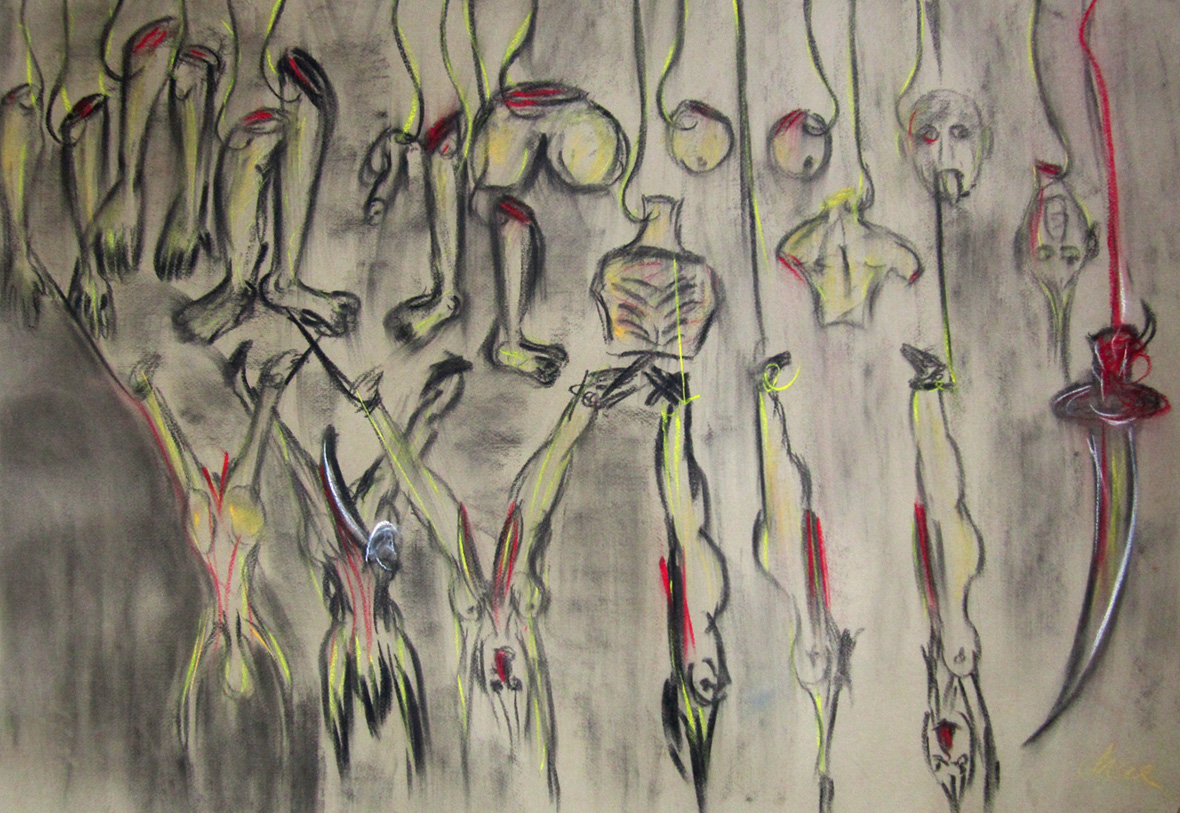
In Search of New Lands
Following the war, Chae moved to the United States where, as an exchange student, he found an interest in literature The rambling, chaotic prose of James Joyce and the Imagist poetry of Ezra Pound comforted him, giving Chae inspiration for his own creative journey. However, his disdain for the rigid structure of the classroom eventually led him to drop out. He spent the next few years bouncing from city to city across America, working various odd jobs. He became a bartender in New York, a bouncer in Miami, and even a karate instructor before eventually settling in New Orleans. It was there, in an atmosphere humid with Jazz and sticky with syncopated rhythms, that Chae’s bohemian heart found its artistic beat. He met his wife and fellow artist, LD Lawrence, and even started an art movement dubbed “The Idists.” New Orleans became a fresh schoolyard for the young artist, a place where he could discover his voice and flesh out his newfound interest in painting.
寻找新大陆
战后,Chae 作为交换学生移居美国,并从那时开始对文学产生了浓烈的兴趣。他从詹姆斯·乔伊斯(James Joyce)散漫的意识流写作和埃兹拉·庞德(Ezra Pound)的意象派诗歌中寻求战后慰藉,也为之后的艺术创作埋下一颗种子。由于不认同学校僵化的课程构架,他最终选择退学。在接下来的几年里,他穿梭于美国各个城市,打着各种各样的零工。他在纽约当过酒保,在迈阿密当过门卫,甚至还曾任过空手道助教,直到最终定居新奥尔良。在这个充满爵士乐和切分节奏的城市里,Chae 自由自在的波西米亚灵魂终于找到了契合艺术的节拍。他还在这里结识了自己的妻子 LD Lawrence,两人甚至一起发起了名为 “The Idists” 的艺术运动。新奥尔良成了这位年轻艺术家新的乐场,让他找到了表达自我的方式,也激发了他对绘画的热情。
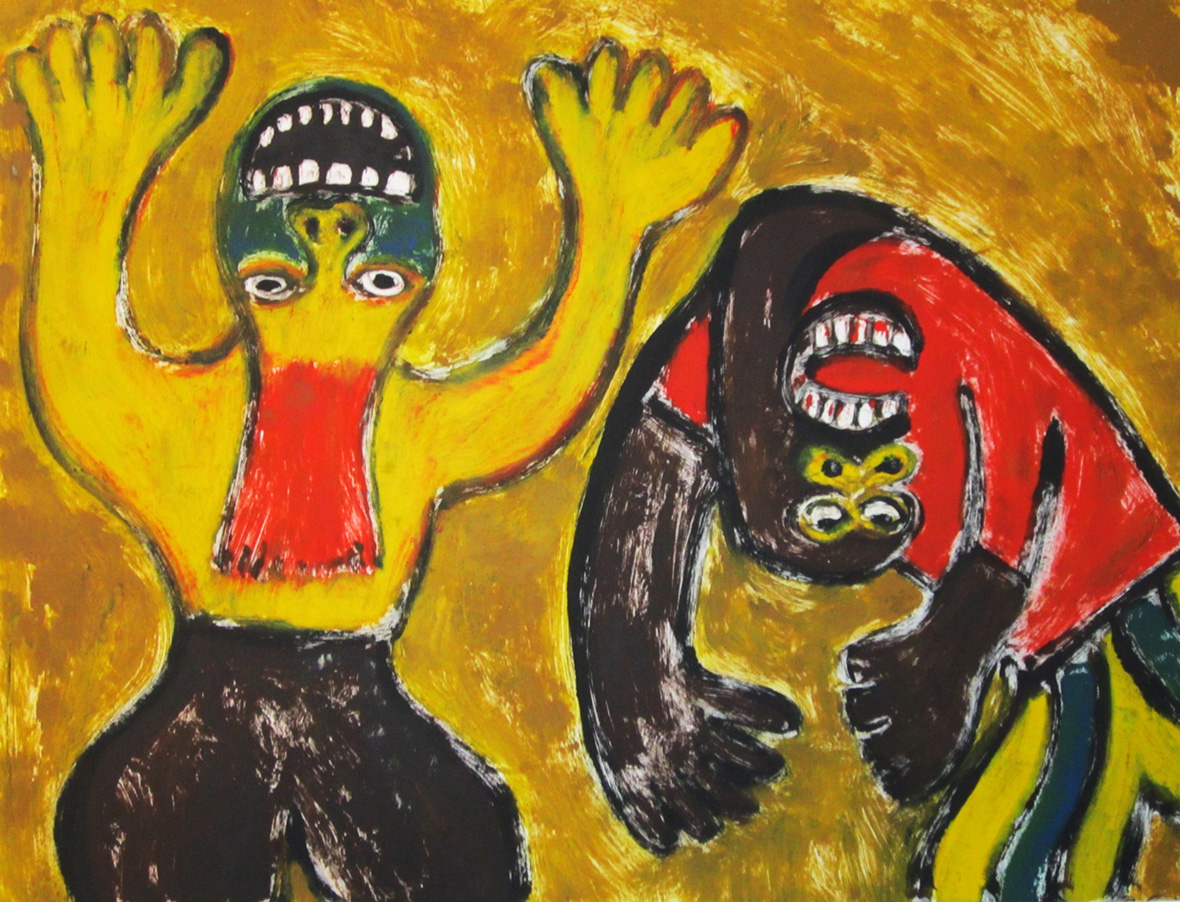
From Goya to Picasso, Chae’s color palette draws from the sensibilities of European fine art while his brash brushstrokes harken back to early elements of Eastern calligraphy, particularly the work of eccentric eighteenth-century Chinese artist Pa-Ta-Shan-Jen. With each new place he visits, each new book he reads, and each new idea he encounters, disparate symbols are introduced, transformed, and incorporated into his work.
“Many of the early Renaissance paintings come from Persian paintings, which in turn were influenced by the Mongols,” he says. “They came and ruled over the Arabic countries, bringing all these Chinese painters and their distinct styles. So in a way, my works travel down from the Himalayas and into the tradition of the Renaissance. Although they may look like Western paintings, they are actually steeped in the silk-road painting tradition.” Just as Chae continuously travelled and gained new experiences, these recurring motifs would interweave and refine themselves into a distinctive style that eventually earned him a reputation in New York City’s booming art market.
从戈雅到毕加索,Chae 在欧洲绘画的感性中汲取灵感;而他写意的笔触则源于早期的东方书法,特别是 18 世纪中国艺术家八大山人的作品。他所造访的每一个新地方,阅读的每一本新书,遇到的每一个新想法,都会被他转化成不同的符号,融入到作品之中。
他说:“许多文艺复兴早期的绘画来自波斯画,而波斯画又受到蒙古人的影响。他们征服和统治了阿拉伯国家,带来了中国画家的作品和截然不同的绘画风格。因此,从某种程度上来说,我的作品也是从喜马拉雅山一路来到文艺复兴的中心。虽然它们看起来像欧美绘画,但实际上却植根于丝绸之路上的传统画法。”之后 Chae 继续四处周游,获取新的经历,这些反复出现的主题元素相互交织,形成他独特的风格,并最终让他在纽约繁荣的艺术市场上赢得一席之地。
Quest for Glory
Following New Orleans, Chae and his wife roadtripped across North America in their van through much of the 1970s, a longing for freedom leading them from the steamy jungles of Yucatan to the sunny beaches of Baja and back again. Since they never kept a permanent residence, tracing their exact route is impossible except through the annotations and stylistic tendencies of Chae’s work, whose written records of dates and locations on the back of canvas lend a treasure-map-like quality to tracking their journey. As time went on, their van filled with paintings, until eventually they began to look for a place to unload them. After the owner of a bookstore in Mexico City suggested the East Village, they knew what they had to do. Chae recounts this experience fondly. “My wife and I looked at each other and said, ‘Jesus Christ, all the way down in Mexico City they know about the East Village! We better go check it out.” So they packed their van headed to New York City, nearly 2,600 miles away.
The glittering skyscrapers of New York in the 1980s were symbols of immeasurable wealth, but the cracked sidewalks and graffiti-littered streets below revealed the grim reality of life lived within the city’s shadows. It was a place populated by drug pushers, prowled by crooks, and forcibly occupied by young artists looking for their big break. Chae had found his home. “At that time, I moved into the most dangerous area in New York. It was a Jewish synagogue surrounded by so many burnt out buildings.” Chae recalls. But as a war veteran, he was accustomed to living in less-than-hospitable environments. He claims, “Still though, even though the windows were all broken and the winter was so cold, I had the mezzanine all to myself. It was a good place to start painting after Mexico.”
追寻荣耀之路
带着对自由的渴望、趁着“爱之夏”嬉皮士运动的余热,七十年代,Chae 和妻子一同离开新奥尔良,他们开面包车横穿整个北美。从尤卡坦半岛的神秘丛林,到加州海滩的明媚阳光,夫妻二人结伴同行。旅途中,他们通常没有固定住所,只能通过作品的注脚和绘画风格变化来追忆路线。Chae 在每一幅画布背后标注了日期和地点,以此来回顾这趟旅程。每次欣赏这些画作,那种感觉就像在翻阅藏宝图。
随着时间推移,车里逐渐塞满了他的作品,以至于途中他们不得不想办法找地方来暂存这些画作。墨西哥城一家书店的老板建议他们去纽约东村试试看,在1960年代,东村以低廉的租金以及 1950 年代披头族在此打下的基础吸引着许多艺术家、音乐家、学生和嬉皮士的光顾。而这个提议,让夫妻二人有了更新的打算。
Chae 说:“我和妻子相互对视,彼此心中已有了答案。”很快,他们收拾行囊,驱车奔赴 2600 英里以外的纽约。 八十年代的纽约,璀璨闪耀的摩天大楼是财富的象征;而向下望去,破败的人行过道和布满涂鸦的街区也揭示着城市暗处的残酷现实。这里鱼龙混杂,毒品贩和骗子随处可见,但也有穷困潦倒的年轻艺术家生活于此。后来,Chae 选择在纽约落脚。“当时,我们住在城市最危险的街区,周围都是损坏和被烧毁的建筑,”Chae 回忆道。但作为一名退伍军人,他早已习惯了恶劣环境。他接着说道:“窗户都破了,冬天非常冷,好在可以独占整个夹层,对于刚从墨西哥回来的我而言,那里像是一个创作的好地方。”
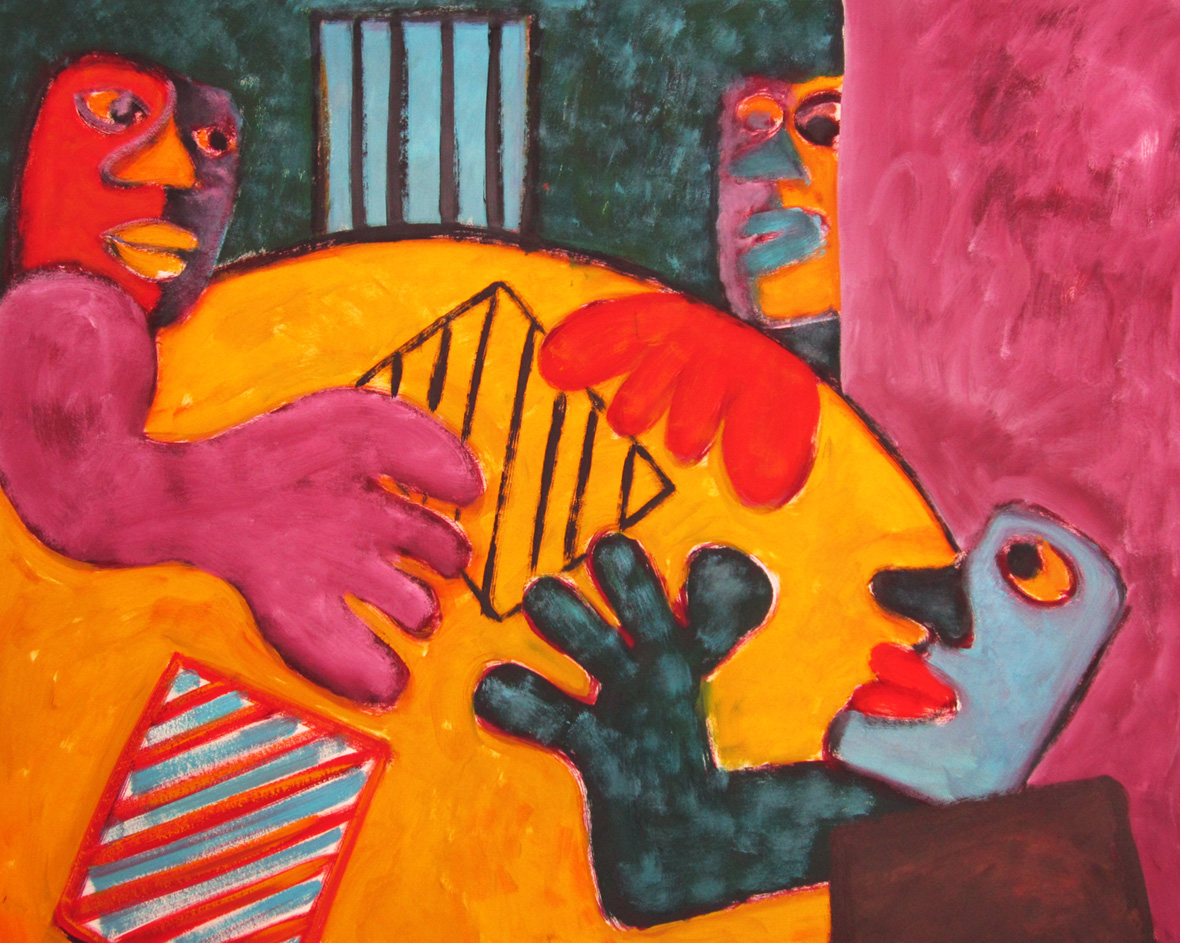
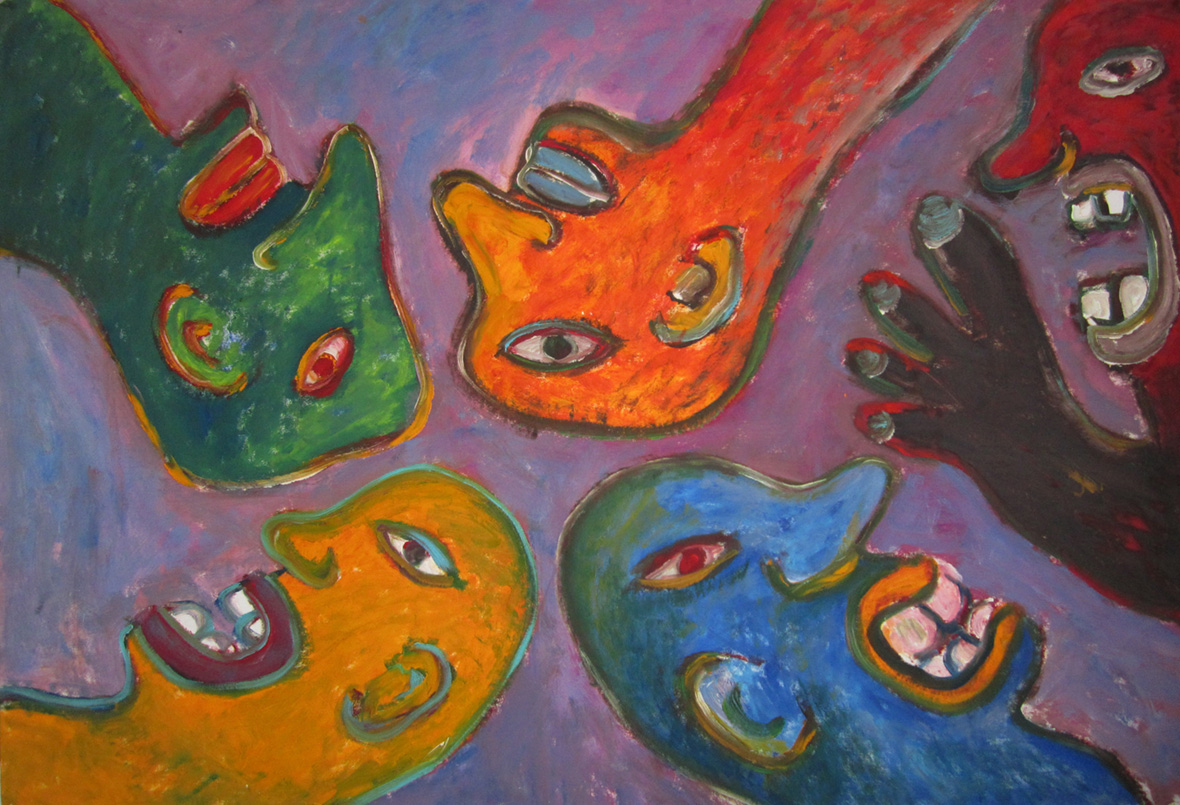
During this time, Chae thrived as an artist. He shared his flat with graffiti sensation Futura, rubbed elbows with Andy Warhol, exchanged words with Jean-Michel Basquiat once or twice at punk-rock concerts, and exhibited his work alongside urban artists Crash and Daze—whom he still talks to today, nearly 40 years later. Yet, despite these connections, his work was largely separate from the greater youth movement taking place within the East Village. Instead of re-appropriating pop imagery or making grandiose critiques about contemporary consumer culture like that of his peers, he found inspiration from an entirely different source: the Middle Ages.
Chae’s breakout exhibition in 1986, Medieval Tales, was a love letter to the lore of centuries past and a test of his artistic ability to convey his passion for literature on canvas. Harnessing his brush like a sword and referencing everything from Arthurian legends to the writings of magical realists Italo Calvino and Anthony Burgess, Chae had emerged as a direct contender against the “edgy” art styles that had become trendy in the East Village of the 1980s. Like characters in a play, the subjects of this series—kings, queens, jesters, knights—seem to appear as apparitions amidst a shifting background that is intentionally flattened in the style of the Middle Ages. By ignoring the conventions of perspective and emphasis on realism that developed during the Renaissance, Chae succeeds in creating a tension that magnifies the subject of his work and casts the canvas as an isolated realm where science and reason have not yet solidified. The theatrically rendered protagonists that inhabit this world are not “real” in the physical sense, nor do they pretend to be. They are steeped in symbolism, existing only through our collective folklore, imagination, and artistic interpretations. Although separated by time and distance, Medieval Tales succeeded in bringing the fantasy of these far-away places and to life, and through the use of exaggeration, Chae leaves the mystery of these magical worlds intact, urging his audience to dive a little deeper, and travel a little farther, to find their own truths in his art.
这段时期,Chae 的艺术创作突飞猛进。他与涂鸦大师 Futura 合租一套公寓、认识了安迪·沃霍尔(Andy Warhol)、在地下朋克摇滚现场上与让–米歇尔·巴斯奎特(Jean-Michel Basquiat)攀谈甚欢、还与城市艺术双人组 Crash & Daze 一起办展,直到 40 年后的今天,他仍然与这两位艺术家保持联络。尽管如此,他的作品在很大程度上独立于纽约东村的主流青年运动。他没有像同龄艺术家那样,着眼于重新演绎流行文化意象,或是对当代的消费文化进行冠冕堂皇的批判,而是从截然不同的领域中汲取灵感:中世纪。
1986 年,Chae 举办展览《Medieval Tales》(中世纪的故事),让他一举成名。展览作品表达了他对数百年前古老传说的偏爱,也考验了他通过画布表达文学主题的艺术能力。其中,他借鉴了各类文学,包括亚瑟王传说,以及魔幻现实主义作家伊塔洛·卡尔维诺(Italo Calvino)和安东尼·伯吉斯(Anthony Burgess)的作品,此时,画笔对于 Chae 而言,成为了讲述故事的工具。这与 1980 年代纽约东村的前卫艺术流行趋势大相劲挺。作品中角色的塑造方式如同戏剧,有国王、皇后、小丑、骑士……背景则被刻意平面化,让人物角色与背影融为一体,同时让观众把注意力放画面的整体上,具有十足的中世纪绘画特色。Chae 摒弃了文艺复兴时期强调的透视法和写实绘法,成功地营造出一种张力,放大作品中的人物,在画布上创造出一个孤立的世界,在那里,科学和理性尚未成熟。却能激发观众的好奇心,去了解更多,探索得更深远,并在他的作品中寻找画作背后的真相。
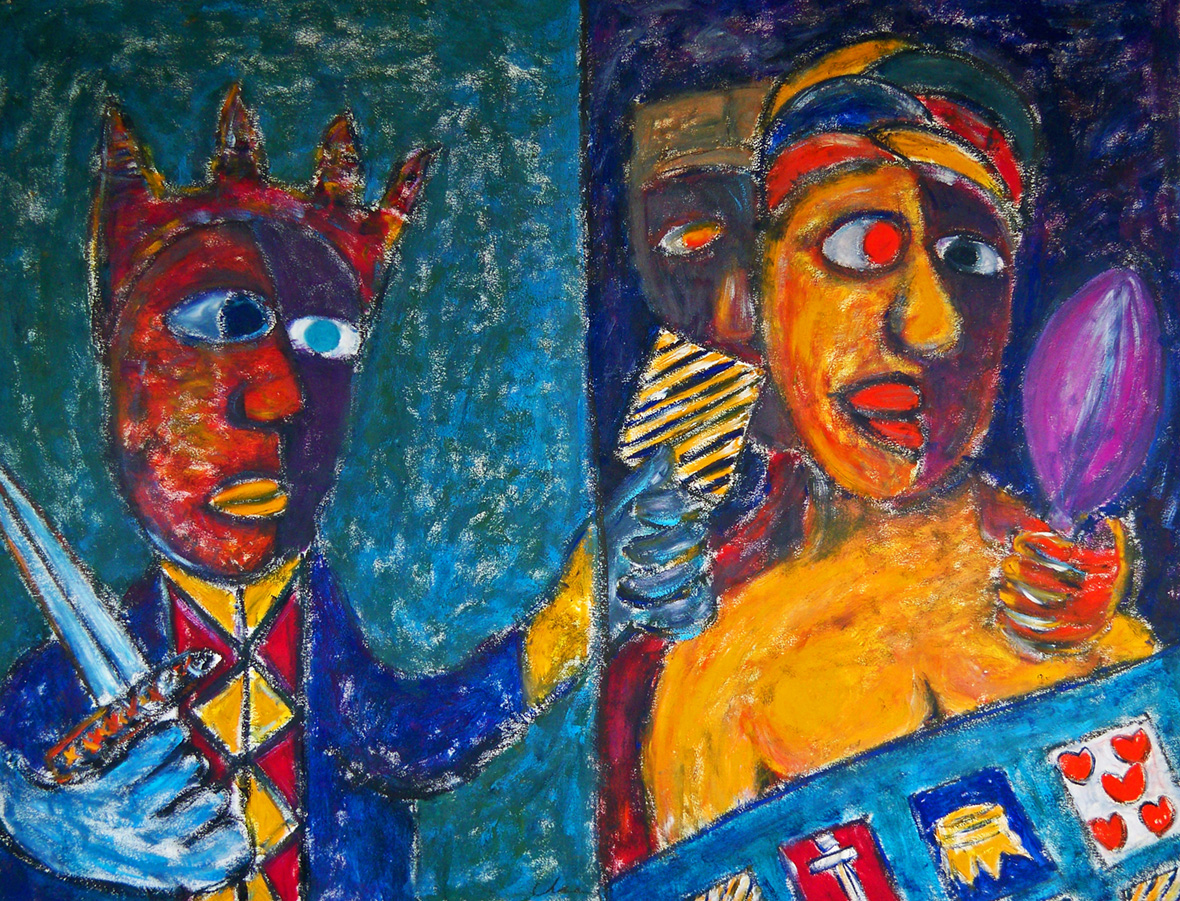
A Hero’s Homecoming, and Farewell
Following the success of Medieval Tales, Chae returned home to Korea after nearly 15 years There, his works were bought up by museums and collectors across the country, which gave him sufficient means to embark on new adventures—such as raising his infant daughter, Isolde. Yet, it wasn’t long before he was back on the road again. This time though, at nearly 50 years old, he was ready to embark on his lifelong dream to hike through the Himalayas and down the silk road, a journey that has always held a profound influence on his imagination and art.
These travels have culminated in the series Himalaya, Silk Road, and Interior Still Life, in which Chae’s art style began to noticeably soften, even as his resolve to travel to greater heights, both physically and artistically, began to harden. His skills haven’t decreased with age in the least bit; they’ve only become more focused as he’s gotten older. Whether its in a damp cave below a Hindu temple or at heights of over 4000 meters high in the Himalayas, at each new destination along the silk road—Urumqi, Zanskar, Kanchenjunga—Chae chose to stay for two to three months at a time to live among the locals and paint. “My wife jokes that I’m an extreme plein-air painter,” he laughs. “But I do it to try and capture real life and feel how those people live. I want to become the same as them, without me being an outsider.”
英雄归乡,又再次启程
继《Medieval Tales》取得成功后,Chae 在离开韩国 15 年后第一次回到家乡。他的作品深受韩国博物馆和收藏家们的追捧,这为他带来充裕的经济支持,去开始新的人生旅程。没过多久,他又离开韩国。这一次,年近半百的他,准备去实现自己毕生的梦想 —— 徒步穿越喜马拉雅山,探寻古老的丝绸之路。在他看来,这趟旅程一直以来对他的艺术创作具有深远的影响。
《Himalaya》(《喜马拉雅山》)、《Silk Road》(《丝绸之路》)和《Interior Still Life》(《室内静物》)系列作品,都是深受这趟旅程的启发而完成的。虽然绘画风格相较以前明显变得柔和,但你却能从画作中明显地感受到攀登高峰时的勇气与坚定。年龄的增长并不会让 Chae 的技艺下降,反倒让他变得更加专注。无论是在印度寺庙下的潮湿山洞里,或是在喜马拉雅山 4000 多米的高处,在丝绸之路上的每一个新的目的地——乌鲁木齐、赞斯卡尔、干城章加峰,Chae 都选择停留两到三个月,在融入当地人生活之后再去创作。“我妻子开玩笑说我是一个极端的’露天派’画家。但我只不过想捕捉最为真实的感受,去参与、去体验当地的生活罢了。我想成为和他们一样的人,而不是一个普通的游客。”他笑着说道。这趟旅行,让 Chae 的艺术眼界又翻过了一座高峰。
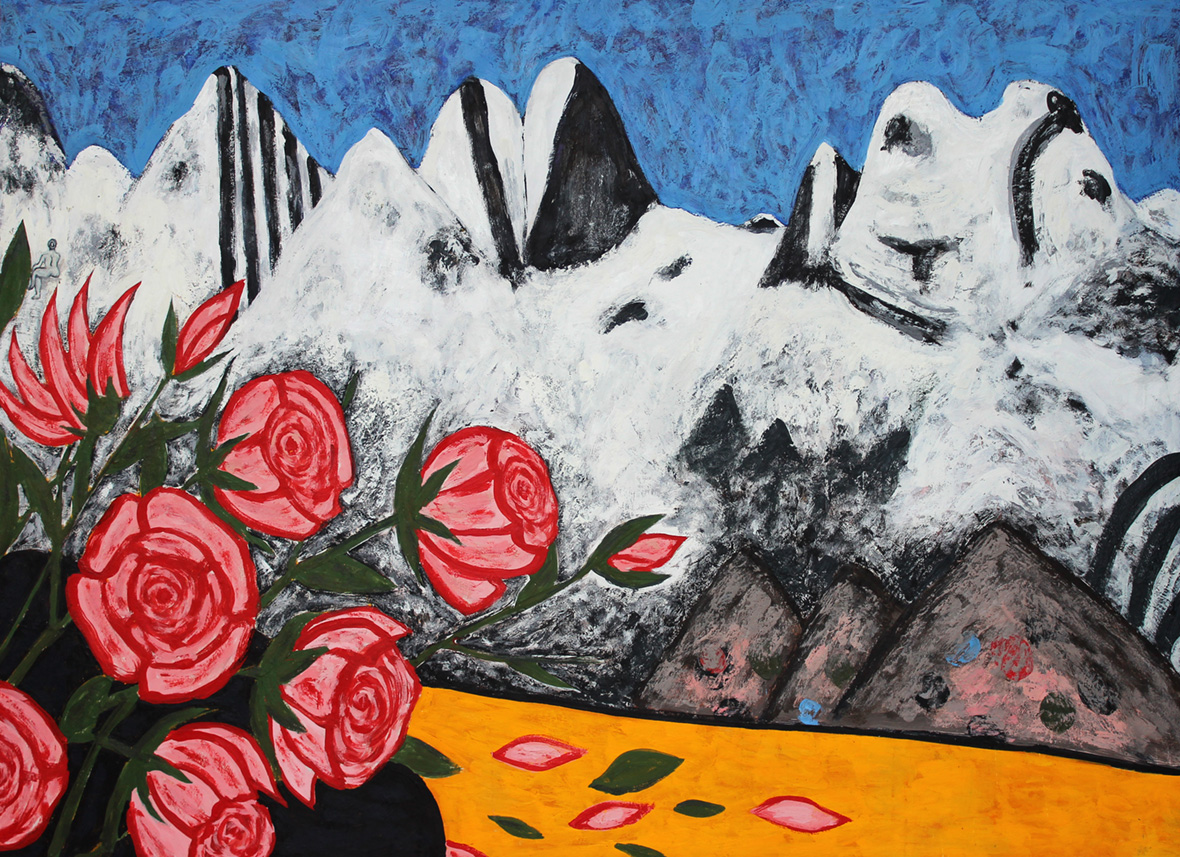
Communion with Nature
Being exposed to the harsh elements of Mother Nature led Chae to reevaluate our relationship with the natural world. “A lot of people think of nature as nice and pleasant, especially the Chinese traditional way of thinking, but nature is very rough,” Chae says. “Nature is heartless. It doesn’t care what we think.”
Even so, the landscapes within his Himalaya and Silk Road series are picturesque portraits of the scenery he’s come across, the lines and contours of the earth treated with the same Fauvist fervor of a nude female painting, sensuous and warm, but ultimately out of reach. In this regard, the accented peaks and valleys we observe are actually a reflection of our own rosy-eyed romanticism regarding our environment, a notion further enhanced by the vibrant flowers found in the corner of his frames that evoke the tradition of still-life paintings in Europe.
与自然的交融
身处严峻的环境,也让 Chae 审视起人类与自然的关系。“很多人认为大自然是美好的,在中国传统观念里尤其如此。但其实真实的大自然却残酷无情。”Chae 说道。虽是这么一说,但他依然希望把大自然最好的一面留给观众。在《Himalaya》和《Silk Road》系列作品中,他画尽了沿途自然的美丽,大地的轮廓,就伫立在裸体女性的身前,温暖诱人,却遥不可及。人物和美景,这些不禁让观众去思考,我们眼中的大自然,是否也被加上了一道美化的滤镜;窗边带有欧洲传统静物画风格的花朵正在盛放,真正的大自然是否与这繁花一样美丽?
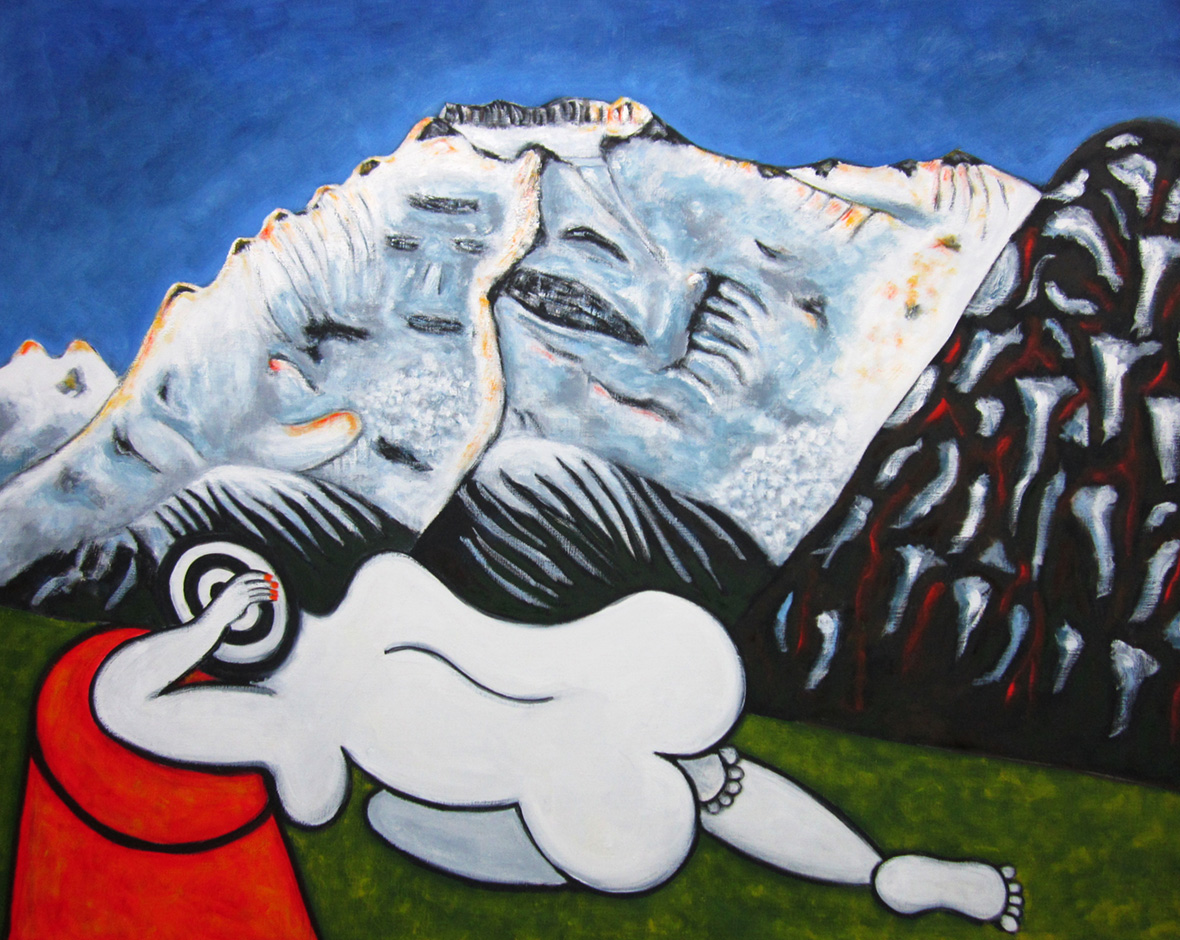
Yet, ironically, our view is often blocked by the near spotlight intensity of Chae’s female subjects, who emerge, porcelain-white and statue-like, as out-of-place characters in his outdoor settings. Modeled off a sculpture of the Hindu goddess Parvati that he encountered while exploring Delhi, these women are naked and exposed to the elements, yet unaffected by their circumstances, indifferent to the male gaze. In fact, Chae claims, “The male gaze is not there at all, maybe not even invited.”
For centuries, the Western tradition of female nudes, landscapes, and still-lifes were treated as subjects of adoration to be conquered by artists and consumed by critics, but by literally turning their backs on us to enjoy the natural scenery on their own terms, Chae’s nude portraits subvert the male gaze and reinforce the indifference of Mother Nature toward humanity. In this regard, perhaps the flowers in the corner of his frames can be viewed more as tributes to her power rather than gifts to win her heart.
然而,具有讽刺意味的是,观众的视线常常被 Chae 描绘的女性人物所吸引,这些雪白如瓷的肌肤,像狡黠的雕像一样夺目,与整个场景格格不入。女性的形象是他以印度教女神帕尔瓦蒂雕塑为原型创作的,她们往往赤裸着身体,袒露于天地,却全然不受任何影响。这种雕塑的手法像是对“男性凝视 (male gaze) 发起的某种挑战,Chae 表示:“男性凝视根本就不存在,也不受欢迎。”
(注:男性凝视指在视觉艺术和在文学创作中,从男异性恋者的角度描绘女性和现实,将女性性客体化以取悦异性恋男性观众的行为,即以男性的、异性恋的观点,把女性视为性对象来表现或再现,满足异性恋男性观看者的愉悦。)
西方的数个世纪以来,女性裸像、风景和静物画是艺术创作的主题,这些主题经历了数代艺术家的雕磨和评论家的点评。而在 Chae 的裸体肖像画中,女性角色背转过身去面朝自然,是对男性凝视的不屑,以及对大自然的敬畏。这样看来,也许画面角落里的花朵更像是对 “女性力量” 的致敬,而不是取悦旁人的礼物。
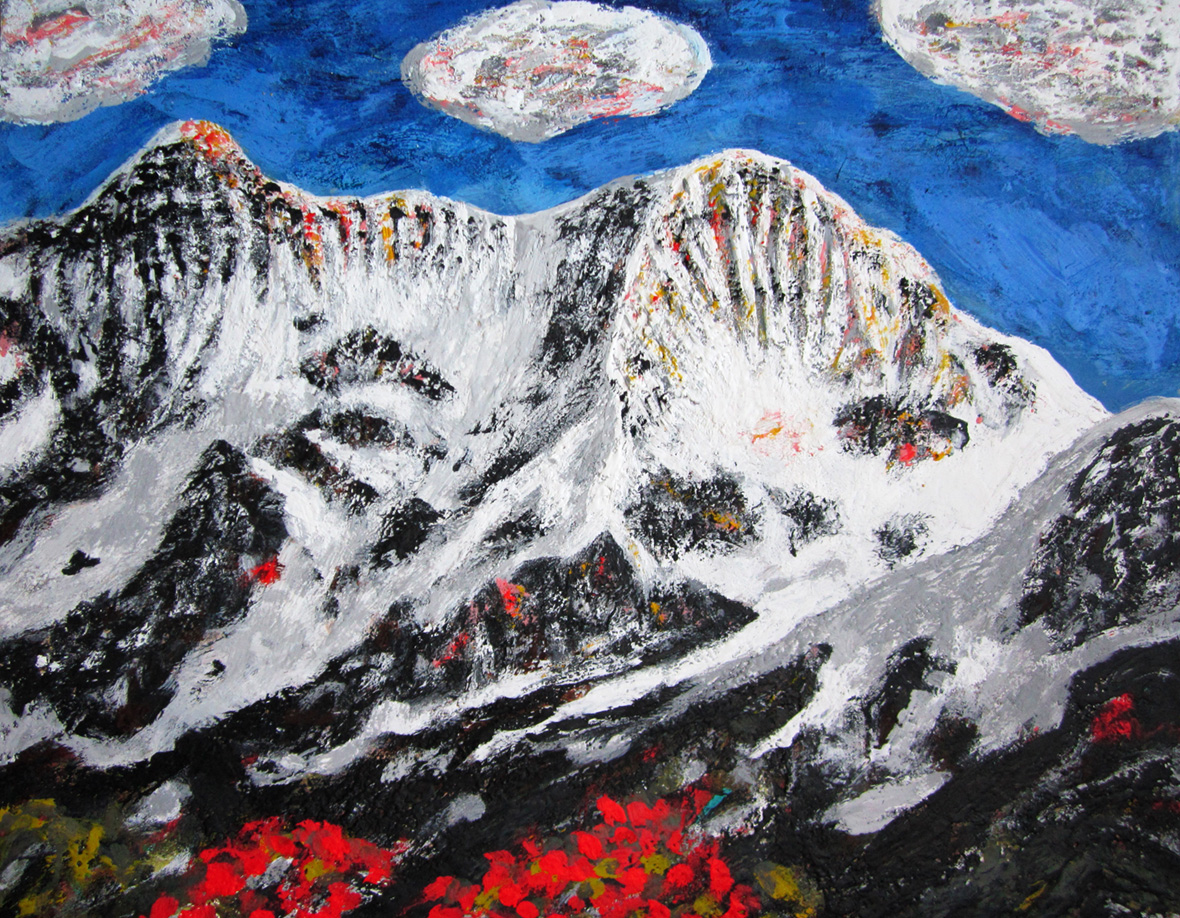
Opening New Routes
In his later travels, Chae transformed the impulsive brushstrokes of his early years into something approaching an elegant fugue. The inclusion of flowers, nudity, and landscapes in his art was an intentional pivot, one that allowed him to frame the focus of his art within the basic pillars of Western composition while acknowledging the inspiration and lineage of landscape painting’s evolution in an Eastern, traditional sense along the silk road. “I really grew up in between two cultures.” Chae says. “I studied Eastern literature when I was young, and then lived in America, and now I’m trying to reconnect with the East again.”
Now, at 70 years old, Chae is well-versed and well-travelled, but far from weary. He is the CEO of his own art agency, and like any experienced merchant, uses the countless points of contacts he’s accumulated across the globe to organize exhibitions for old friends throughout Asia. For the 17 year boy who once harbored ambitions of becoming an ambassador, Chae seems to have succeeded. “Now in many ways, all these artists from New York, their dealers, their galleries, regard me as their ambassador to Asia,” he says. “And I take it seriously.” Likewise, as a veteran in more ways than one, Chae is confident that his latest ventures in China will be successful in not only opening up new markets, but exposing a wider audience to fresh artistic ideas. “I want to put myself in the middle, as a sort of conduit. That’s what the silk road was all about. From Asia all the way to Rome and back, and witnessing how all the art had influenced and changed the globe.
启航新征程
在后来的旅行中,Chae 早前不修边幅的笔触,已转变得近乎雅致。花卉、裸体和风景成为他画作的中心,西方文学创作的框架被注入其中,裹挟着丝绸之路上东西方艺术创作的灵魂。“我在这两种文化中成长。我来自东方,却在美国生活。现在,我正试图重新与东方联系起来。” Chae 说道。
如今,七旬老人 Chae 虽早已周游列国,沉淀下不少经历和学识,但他从未松懈倦怠。他在自己开办的艺术经纪公司担任 CEO,和经验丰富的商人一样,利用自己在世界各地的人脉,为亚洲各地的艺术家友人举办展览。对于在 17 岁时曾经梦想成为外交大使的 Chae 来说,他似乎已经成功了。他说:“现在,很多西方或是纽约的艺术家、经销商和画廊,都把我当作他们面向亚洲的一扇窗,这让我对工作更加上心。” 近来,Chae 计划进入中国,他相信能够凭借积累的丰富经验,为中国艺术市场带来新的可能,更为中国观众带来与众不同的艺术思想。“我想作为中间人,发挥像桥梁一样的连接作用,这也是丝绸之路的意义所在,通过亚洲与罗马之间的往来,共同改变世界。”
Like our stories? Follow us on Facebook and Instagram.
Contributors: Rorí Mencin
Chinese Translation: Olivia Li

